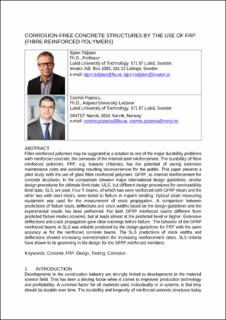| dc.description.abstract | Fibre reinforced polymers may be suggested as a solution to one of the major durability problems with reinforced concrete; the corrosion of the internal steel reinforcement. The durability of fibre reinforced polymers, FRP, e.g. towards chlorides, has the potential of saving extensive maintenance costs and avoiding resulting inconveniences for the public. This paper presents a pilot study with the use of glass fibre reinforced polymers, GFRP, as internal reinforcement for concrete structures. In the comparison between major international design guidelines, similar design procedures for ultimate limit state, ULS, but different design procedures for serviceability limit state, SLS, are used. Four T-beams, of which two were reinforced with GFRP rebars and the other two with steel rebars, were tested to failure in 4-point bending. Optical strain measuring equipment was used for the measurement of crack propagation. A comparison between predictions of failure loads, deflections and crack widths based on the design guidelines and the experimental results has been performed. For both GFRP reinforced beams different from predicted failure modes occurred, but at loads almost at the predicted level or higher. Extensive deflections and crack propagation gave clear warnings before failure. The behavior of the GFRP reinforced beams in SLS was reliable predicted by the design guidelines for FRP with the same accuracy as for the reinforced concrete beams. The SLS predictions of crack widths and deflections showed increasing overestimation for increasing reinforcement ratios. SLS criteria have shown to be governing in the design for the GFRP reinforced members. | |
